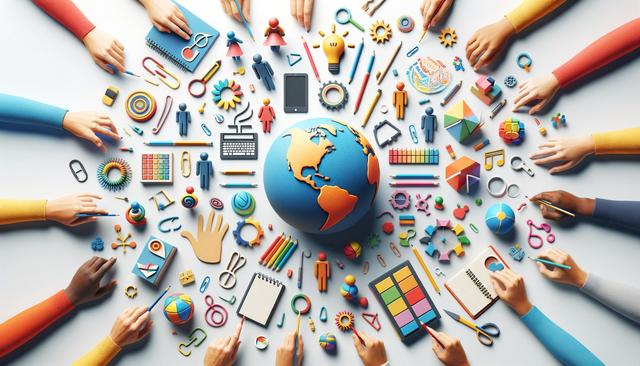
Navigating Support: A Guide to Learning Disabilities Resources
Understanding Learning Disabilities
Learning disabilities are neurologically-based processing disorders that can interfere with fundamental learning skills such as reading, writing, and math, as well as higher-level skills like organization, time planning, abstract reasoning, and memory. These challenges are not indicative of intelligence levels but rather reflect differences in how individuals process information. Common types of learning disabilities include dyslexia, dyscalculia, dysgraphia, and auditory or visual processing disorders. Understanding these differences is crucial for identifying the right educational strategies and interventions.
Early diagnosis and intervention play a pivotal role in managing learning disabilities. Parents, educators, and healthcare professionals must work together to observe signs such as difficulty following instructions, inconsistencies in academic performance, or struggles with reading comprehension. These indicators typically become noticeable in early school years and should prompt a comprehensive evaluation by a qualified specialist. Once a diagnosis is established, it becomes easier to identify tailored resources that can support the individual’s learning journey.
Educational Tools and Technology
Technological advancements have significantly expanded the range of educational tools available to individuals with learning disabilities. Assistive technology can help bridge the gap between learning challenges and academic success. Tools vary depending on the specific disability and the individual’s needs, but some widely used resources include:
- Text-to-speech software to aid with reading comprehension
- Speech-to-text tools for students with writing difficulties
- Graphic organizers to assist with information structuring
- Specialized apps that focus on phonics, spelling, or arithmetic
These tools not only support academic performance but also help build confidence and independence. Choosing the right technology involves understanding the learner’s strengths and challenges, and often requires guidance from educators or therapists familiar with assistive solutions. Many schools and learning centers incorporate these technologies into Individualized Education Programs (IEPs) or 504 Plans to ensure that students receive consistent and appropriate support.
Support Services in Schools
Most educational systems provide structured support for students with learning disabilities through special education services. These services are typically accessed through an evaluation process that leads to the development of an Individualized Education Program (IEP) or a 504 Plan, which outlines accommodations, goals, and support services for the student. Key components of these plans include:
- Modified teaching strategies
- Extended time on tests and assignments
- Access to resource rooms or specialized instruction
- Speech and occupational therapy if needed
It’s essential for parents and guardians to be actively involved in the planning and review meetings associated with these services. Collaboration between educators, families, and students ensures that the support strategies remain effective and evolve with the student’s changing needs. Teachers also benefit from professional development opportunities that equip them with the skills to support diverse learners in inclusive classroom settings.
Community and Online Resources
Beyond the classroom, community and online resources offer additional avenues of support for individuals with learning disabilities. Local nonprofit organizations, libraries, and community centers often provide tutoring, workshops, and parent support groups. These resources can be invaluable for families navigating the complexities of learning disabilities.
Online platforms also offer a wealth of information and tools, including:
- Webinars and online courses for parents and educators
- Interactive learning tools and games designed for specific learning challenges
- Forums and communities where families can connect and share experiences
- Downloadable templates for IEP organization and academic planning
These resources promote a sense of community and shared understanding, especially for families in remote or underserved areas. By participating in both local and digital networks, individuals with learning disabilities and their families can access continuous support tailored to their unique needs.
Guidance from Specialists and Advocacy
Working with trained specialists such as educational psychologists, learning disability tutors, and speech-language pathologists can significantly enhance the educational experience for students with learning challenges. These professionals conduct assessments, create personalized intervention plans, and provide ongoing support tailored to individual needs. They also serve as advocates, helping families navigate school systems and ensuring that appropriate accommodations are in place.
In addition to individual support, advocacy organizations play a vital role in promoting awareness and policy change related to learning disabilities. These groups provide families with information about their rights under disability laws and help them seek equitable treatment in educational settings. Some advocacy efforts also focus on teacher training, curriculum development, and inclusive policy reforms.
Families are encouraged to stay informed about their legal rights and to seek guidance when needed. Being proactive in advocating for appropriate resources not only improves educational outcomes but also empowers students to advocate for themselves as they grow older.
Conclusion: Empowering Learners Through Resources and Support
Accessing the right learning disabilities resources can make a meaningful difference in the lives of students and their families. From assistive technologies and school-based support to community programs and professional guidance, these tools collectively help bridge learning gaps and promote personal growth. The journey may require persistence and collaboration, but with the proper support, individuals with learning disabilities can thrive academically and beyond. Staying informed and engaged is key to unlocking each learner’s full potential.